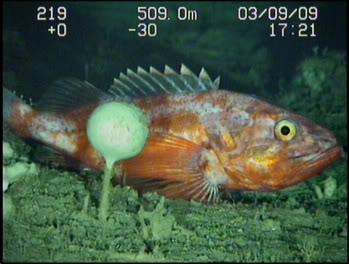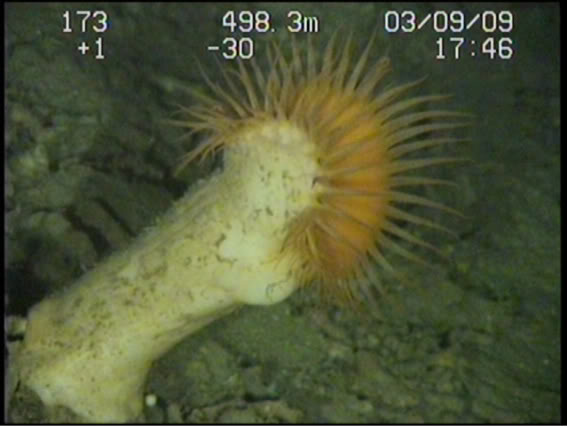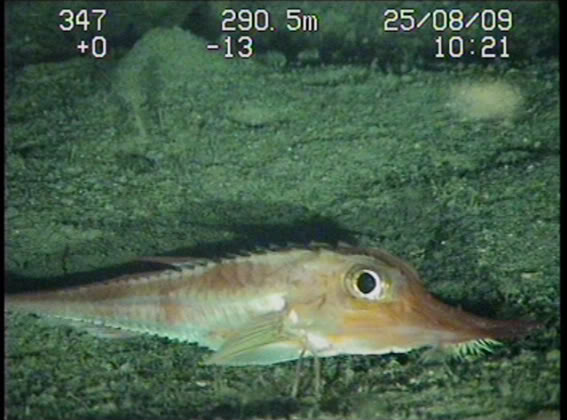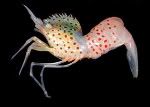Owned by Spain, but located just off the northwest coast of Africa, the Canary Islands sport a wide variety of marine life, including five species of marine turtles, ten species of sharks and rays, and innumerable fish and invertebrates. However, a new expedition has gone beyond the known, sending a robot to depths of 500 meters to discover the secrets of the Canary Island’s deep sea.
Carried out by Oceana and Fundación Biodiversidad (Spain), the expedition has discovered approximately twelve new species, including glass and rock sponge; ball, white and black coral, and an armored searobin. The robot, equipped with a video camera, also took footage of little-known species, some of which have never before been filmed in their natural habitat, including channeled rockfish, anglerfish, silver and pink gallo fish, fan coral, bathyal sea fans, Venus fly-trap anemones, and lollipops sponges.
  Top: Glass sponges (Asconema setubalense) field. NW La Gomera, Spain. Canary Islands Oceana Ranger Expedition. August 2009. Bottom: Channeled rockfish (Setarches guentheri) with unidentified sponge. 509 meters depth. South of Mogan, Gran Canaria, Spain. Canary Islands Oceana Ranger Expedition. August 2009. Photos © OCEANA. |
The expedition’s goal is to identify species rich areas that should be made into Marine Protected Areas (MPAs). While the United Nations has called for 10 percent of the ocean to be protected, currently the EU has set aside 2.7 percent while the Canary Islands have protected only 0.15 percent of its nearby waters.
“The lack of knowledge of the communities existing at great depths is one of the biggest problems when it comes time to decide which areas must be protected,” says Ricardo Aguilar, Director of Research for Oceana Europe. “The narrow platform existing around the islands makes the bottoms drop steeply to 1000 and 3000 meters, making it difficult to learn about them. It is essential that different habitats and species are included in the protected marine areas, since these serve as a refuge and breeding ground for the rest of the coastal and oceanic areas surrounding the archipelago”.
The expedition has been ongoing for a month with the robot having dived 40 times off of 6 of the 7 islands in the Canary Islands archipelago. The next month will visit the last island and revisit the other as well, says Oceana.

Venus fly-trap anemone (Actinosyphia saginata). 498 meters depth. Mogan, Gran Canaria, Spain. Canary Islands Oceana Ranger Expedition. August 2009. Photo © OCEANA.

African armored searobin (Peristedion cataphractum) Bocayna Strait, Lanzarote, Spain. Canary Islands Oceana Ranger Expedition. August 2009. Photo © OCEANA.
Related articles
Three new species discovered in mile-long underwater cave

(09/01/2009) There are few places in the world more remote, more dangerous, and more unexplored than underwater caves. Cave diving—exploring these unknown abysses—has yielded many strange species unknown to science. A recent expedition to an underwater cave on Lanzarote, one of the Canary Islands, was no exception. Researchers discovered two species of worm smaller than a grain of rice and a primitive poisonous crustacean.
Newly discovered deep sea worms throw bioluminescent ‘bombs’

(08/20/2009) Researchers from Scripps Institution of Oceanography at UC San Diego have announced in Science the discovery of seven new species of deep sea worms, five of which drop orb-like parts of their body which cause a brilliant green display of bioluminescence. For this reason researchers have nicknamed them the ‘green bombers’. The worms are not just new species, but a clade of animals entirely unknown to science until now.
Ebay bidders to decide new shrimp’s name

(03/24/2009) A new way to raise conservation funds has captured attention worldwide. The Australian Marine Conservation Society (AMCS) has auctioned the naming rights of a newly discovered species of shimp Ebay. “The shrimp is in the group or genus of shrimps known as Lebbeus, but is awaiting the addition of a unique species name,” said Anna McCallum, a Melbourne scientist who discovered the new species in deep waters off the Southwest coast of Australia.
Seven new species of deep sea coral discovered
(03/09/2009) In the depths of the Papahānaumokuākea Marine National Monument, which surrounds ten Hawaiian islands, scientists discovered seven new species of bamboo coral. Supported by the National Ocean and Atmospheric Administration (NOAA), the discoveries are even more surprising in that six of the seven species may represent entirely new genus of coral.
Photos: 13,000 species found in Arctic, Antarctic Oceans

(02/16/2009) A marine census has documented more than 13,000 species in the Arctic and Antarctic Oceans, including several hundred that may be new to science. Conducted over a two-year period under often perilous conditions — including monster waves and dangerous polar bears — the series of 18 surveys turned up a wealth of information on the diversity, distribution and abundance of marine life. The research will also help establish a baseline for measure changes in polar ecosystems.
Hundreds of rare and bizarre marine species discovered
(11/09/2008) The evolutionary origin of deep sea octopuses, new species populating an underwater “continent”, 12,000 amphipods crowding a square meter in the Gulf of Mexico, massive gatherings of white sharks in the middle of the Pacific: these are just a few highlights from the Census of Marine Life (COML)’s fourth report.